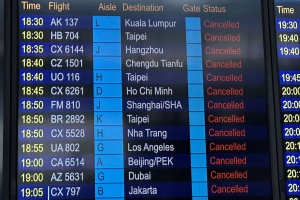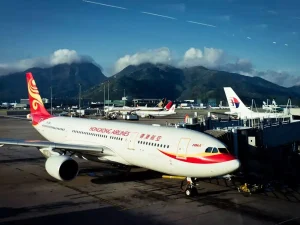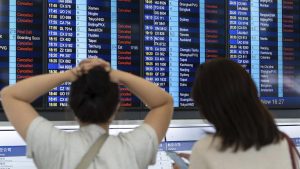Hong Kong – Typhoon Ragasa, officially recognized as 2025’s most powerful tropical cyclone, has forced Hong Kong’s aviation industry into an unprecedented mass evacuation operation. The devastating storm prompted airlines to relocate approximately 80% of their aircraft fleet to safer locations across multiple countries, marking one of the largest aviation safety operations in recent history.
As Typhoon Ragasa approached Hong Kong with hurricane-force winds and torrential rain, the city’s aviation sector implemented emergency protocols to protect billions of dollars worth of aircraft. The storm’s intensity and projected path left airlines with no choice but to execute complex evacuation procedures across international boundaries.
Massive Flight Disruptions and Airport Closures

Hong Kong International Airport, ranked as the world’s busiest cargo airport and ninth busiest for international passenger traffic, completely suspended all landings and departures for 36 hours starting Tuesday evening. This unprecedented shutdown demonstrates the serious threat posed by Typhoon Ragasa to aviation operations in the region.
Cathay Pacific Airways, Hong Kong’s largest airline, announced on Monday that Typhoon Ragasa would have “a significant impact” on operations, leading to the cancellation of more than 500 long-haul and regional flights. The airline, operating a fleet of 179 passenger and freighter aircraft, faced substantial operational challenges as the storm approached.
The Hong Kong government issued typhoon signal 10, its highest warning level, early Wednesday morning, effectively shutting down businesses and transport services across the territory. This maximum alert level underscores the exceptional danger presented by Typhoon Ragasa to the densely populated financial hub.
Strategic Aircraft Relocation Operations


Flightradar24 tracking data revealed the scale of aircraft evacuation operations, showing that approximately 80% of planes belonging to Hong Kong’s four main airlines had been strategically relocated to airports across Japan, China, Cambodia, Europe, Australia, and other locations. This massive logistical operation represents standard industry practice during major weather events.
At least 14 Cathay Pacific jets were tracked flying from Hong Kong to Cambodia’s Phnom Penh Techo airport on Tuesday to wait out Typhoon Ragasa. This relocation strategy serves dual purposes: protecting valuable aircraft from potential damage and positioning planes for rapid service restoration once the storm passes.
The Hong Kong Business Aviation Centre confirmed that the majority of the city’s business jet fleet also evacuated the territory ahead of Typhoon Ragasa, indicating the broad consensus among aviation operators about the storm’s potential destructive capacity.
Individual Airline Response Strategies
Greater Bay Airlines, a smaller Hong Kong-based carrier operating seven aircraft, evacuated all planes from the territory as a safety precaution against Typhoon Ragasa. The airline’s Boeing 737s were tracked flying to airports in Japan and China on Tuesday, demonstrating even smaller operators’ commitment to aircraft protection.
Hong Kong Airlines similarly relocated all but one of its 28 aircraft away from Hong Kong, according to tracking data. This near-complete evacuation illustrates the aviation industry’s unified response to the threat posed by Typhoon Ragasa.
Also Read: Saudi Pakistan Defense Pact: Game-Changing Alliance with Big Implications for India?
Cathay Pacific and its low-cost subsidiary H.K. Express adopted a mixed approach, keeping some aircraft in Hong Kong while relocating others. Historical data from 2017 shows Cathay has previously used airport hangars to shelter some aircraft during cyclones while sending others to alternative destinations.
Aviation Safety Protocols and Insurance Compliance


The massive aircraft evacuation operation reflects standard industry protocols designed to minimize potential damage from extreme weather events. Airlines routinely relocate aircraft to comply with insurance obligations and protect substantial investments in aviation equipment when faced with storms like Typhoon Ragasa.
During high-wind events, airlines employ various protective measures including storing aircraft in hangars, adding extra fuel to increase weight and stability, and securing smaller aircraft with tie-down equipment. These procedures have proven essential during major weather events throughout aviation history.
The preemptive positioning of aircraft also serves operational purposes, allowing airlines to resume services more quickly once Typhoon Ragasa passes and conditions improve. This strategic approach minimizes recovery time and helps restore normal operations faster.
Recovery Operations and Future Impact


Cathay Pacific announced expectations for a “staggered and gradual resumption” of scheduled services throughout Thursday and Friday following Typhoon Ragasa’s passage. This phased approach reflects the complexity of coordinating aircraft returns and crew repositioning after such a massive evacuation operation.
The economic impact of Typhoon Ragasa extends beyond immediate flight cancellations to include substantial costs associated with aircraft relocation, crew positioning, and passenger rebooking. However, the aviation industry’s proactive response demonstrates the effectiveness of established emergency protocols in protecting both human life and valuable aviation assets from nature’s most powerful forces.

